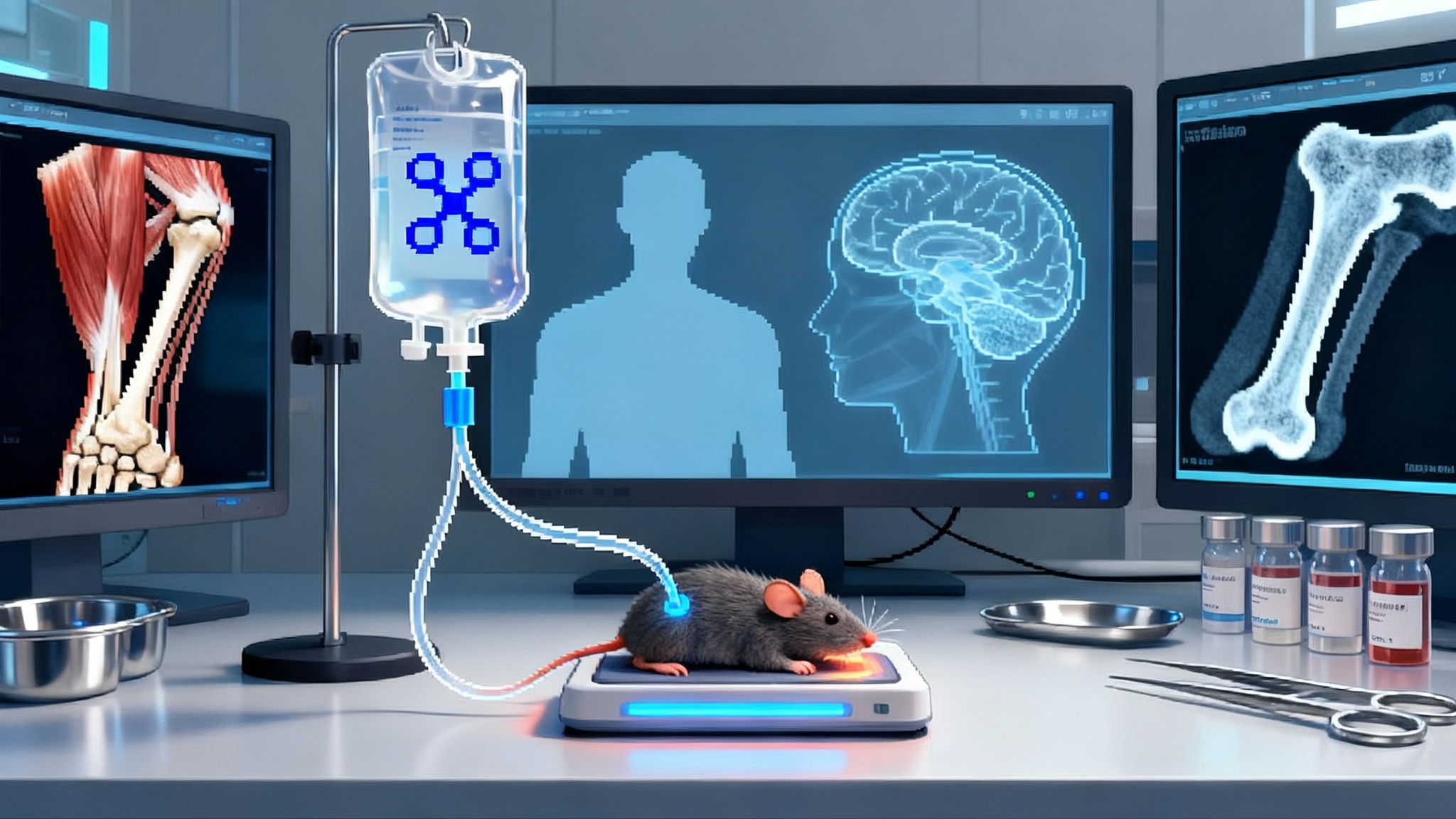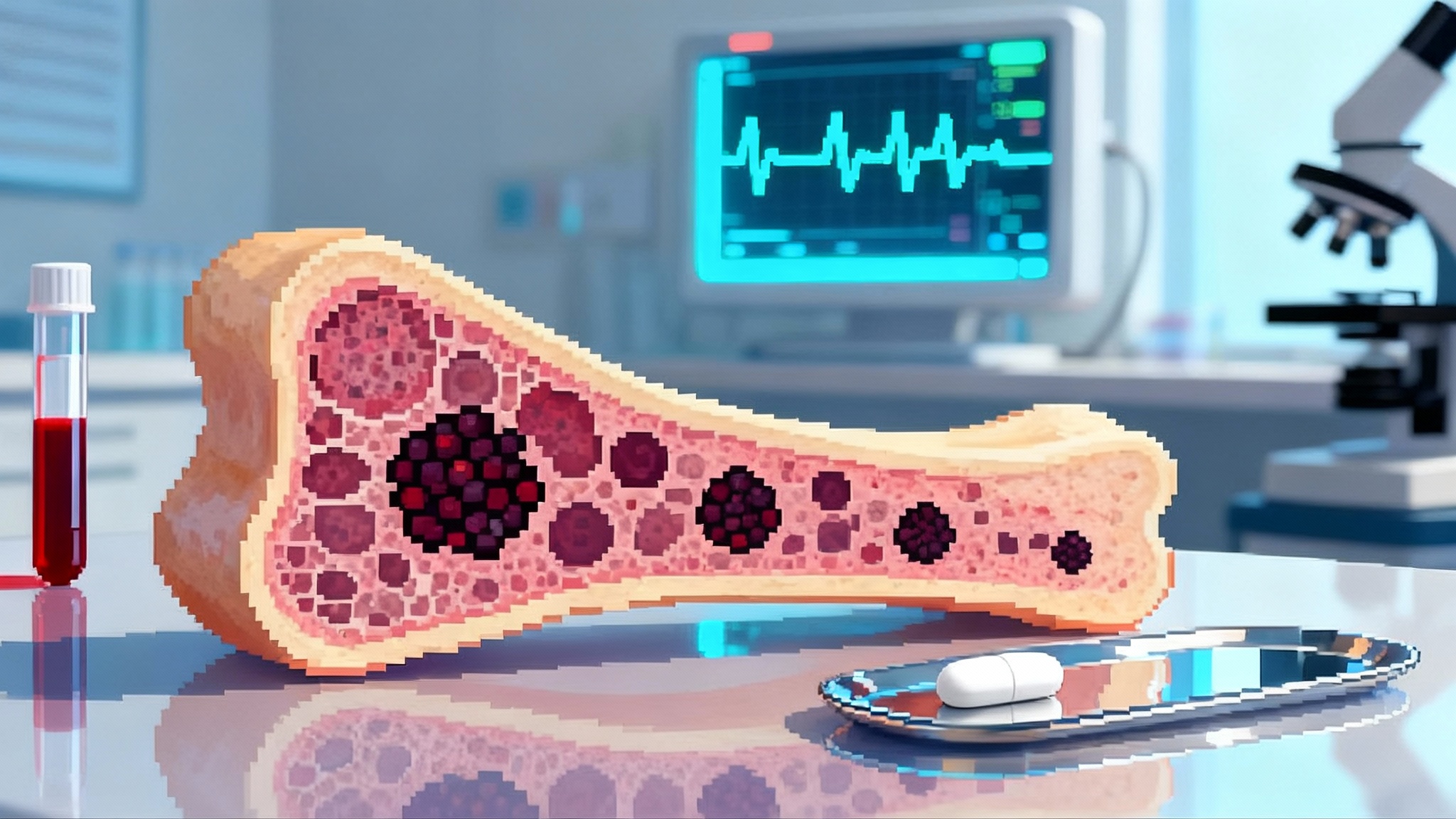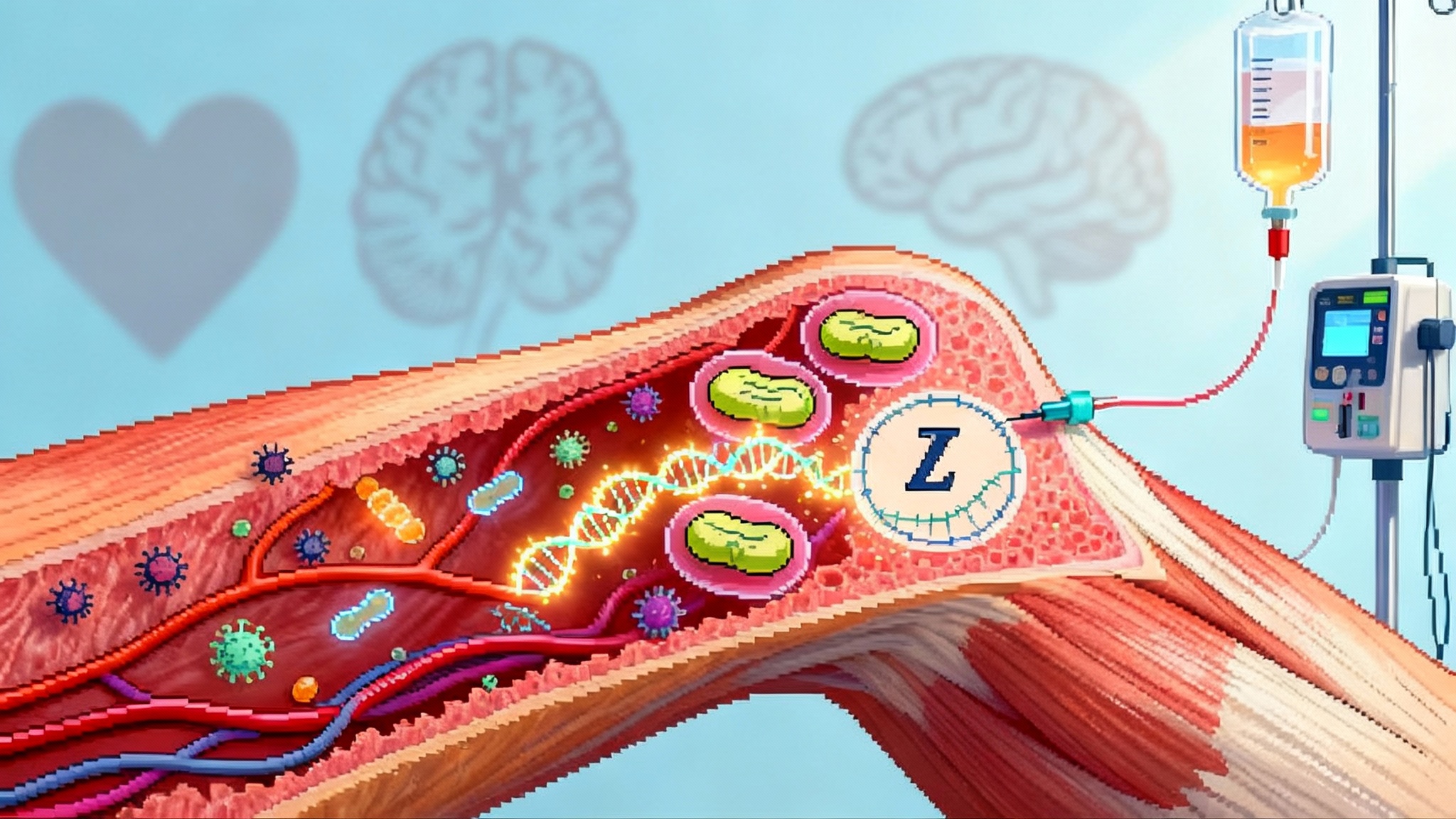Klotho gene therapy’s 2025 cross‑over to first‑in‑human
A 2025 Molecular Therapy study reported that a single AAV dose elevating secreted Klotho extended male mouse lifespan by roughly 15 to 20 percent and improved aging markers. Here is a concrete, risk-aware plan to reach early human trials, with routes, biomarkers, and go or no go gates.

The mouse result that raised the bar
Aging research is full of eye-catching claims. Most fade after a second look. The April 2, 2025 study that put secreted Klotho on the map read differently. In wild-type mice, one adeno-associated virus dose that raised circulating secreted Klotho extended male lifespan by roughly 15 to 20 percent and improved several health markers. The same work reported stronger muscles, better bone microstructure, and hippocampal changes consistent with healthier brain aging. This was not a supplement study and not a short experiment; it was peer-reviewed work with a clear mechanistic target in a top translational journal. See the 2025 Molecular Therapy paper on secreted Klotho.
This result fits a broader 2025 pattern where once-theoretical longevity ideas are turning into development programs, from turning immune aging into treatable biology to PCSK9 base editing in prevention and the first randomized plasma exchange trial.
Klotho, briefly and plainly
Klotho exists in two main forms. The membrane-bound protein helps kidney cells regulate phosphate handling through fibroblast growth factor 23. The secreted isoform circulates and behaves like a hormone. When levels fall with age, cells experience more oxidative stress and inflammatory signaling and less healthy crosstalk across insulin, IGF-1, and Wnt pathways. The 2025 study took the straightforward path: raise secreted Klotho, watch whether the organism ages more slowly, and measure whether tissue function looks younger. That is what the authors reported.
From mouse to human: what must change and what must not
There is real risk in copying mouse methods into people.
- Route and dose. The mouse study used AAV9 with combined intravenous and central delivery. In people, intravenous AAV9 at CNS-effective doses can drive liver stress and capsid-directed immunity. Intrathecal or intracisterna magna dosing can lower total capsid exposure and focus on the CNS but provides limited access to peripheral tissues like skeletal muscle and bone. The translation plan must treat route as a design choice tied to the first indication.
- Promoter choice. A ubiquitous promoter can drive broad expression but raises off-target risk. Tissue-selective promoters aim expression where the biology is most urgent. For amyotrophic lateral sclerosis, muscle-directed expression can target the neuromuscular junctions that wither in disease. Academic groups have already described muscle-targeted secreted Klotho programs now licensed to a U.S. company.
The near-term clinical logic: start where regulators have a path
Two initial indications make sense if the goal is to move fast without cutting corners.
-
Amyotrophic lateral sclerosis (ALS). The disease is uniformly progressive, measurements such as the ALS Functional Rating Scale and respiratory function are well established, and orphan incentives help. Klotho’s biology intersects neuroinflammation, excitotoxic stress, and muscular regeneration. A muscle-targeted secreted Klotho vector can bathe neuromuscular junctions while allowing some spillover into the CNS through cerebrospinal fluid exchange. In July 2025, the licensed Klotho program received U.S. Orphan Drug Designation, a pragmatic signal that a development path is plausible.
-
Early cognitive impairment with Alzheimer’s biomarkers. Here the case is grounded in systems biology: secreted Klotho has shown effects on synaptic function and adult neurogenesis in mice. For a first-in-human test, the goals should be safety and target engagement in cerebrospinal fluid, not a disease-modifying claim. That aligns with the FDA gene therapy guidance for neurodegenerative diseases.
Safety ledger: the big risks and concrete mitigations
Immunogenicity to the vector and the transgene
Most adults have been exposed to AAV in the wild. Many carry binding antibodies, and some carry neutralizing antibodies that block transduction. Cellular immunity can target the capsid or the newly expressing cells. The result can be loss of effect, liver enzyme spikes, or worse. Mitigations: pre-screen for neutralizing antibodies, choose routes that lower total capsid exposure, use steroid prophylaxis, and escalate dose carefully.
Off-target effects and overexpression
Secreted Klotho sits inside hormone networks. Excessive levels may disturb phosphate and calcium homeostasis or trigger effects in unintended tissues. Design choices can help: tissue-selective promoters, microRNA target sequences that silence hepatocyte expression, and conservative dose steps. Operationally, monitor serum phosphate, calcium, parathyroid hormone, vitamin D metabolites, and FGF23 alongside primary endpoints in first cohorts.
Biodistribution and shedding
Before first-in-human dosing, GLP biodistribution in rodents and confirmatory studies in nonhuman primates should map where the vector goes for the selected route. Sampling should include brain regions, dorsal root ganglia, spinal cord, liver, kidney, gonads, and the injection tract if applicable. Shedding studies in blood, urine, stool, and for intrathecal dosing, cerebrospinal fluid, are expected. Plan these packages to align with ICH S12 expectations.
Tumorigenicity and genotoxicity
AAV vectors have a low integration rate but not zero. Integration near growth-control genes has been observed in some animal studies. Responses: include integration site analysis in a subset of subjects, avoid unnecessarily strong promoters in proliferating tissues, and plan long-term follow-up typical of gene therapy programs.
Biomarkers that make decisions faster
The job is not to prove Klotho is interesting; it is to show that one engineered construct moves a human disease signal.
- Target engagement. Quantify secreted Klotho in plasma and cerebrospinal fluid with validated immunoassays. Predefine fold-change thresholds at week 4, week 12, and week 24.
- Tissue function proxies. In muscle, use grip strength, isometric knee extension, and six-minute walk distance. In bone, measure lumbar and hip areal BMD with DXA and run a high-resolution peripheral QCT sub-study for microstructure. In the brain, track hippocampal volume and microstructural MRI metrics, plus a computerized cognitive composite tuned to episodic memory and executive function.
- Disease-specific markers. For ALS, track plasma and CSF neurofilament light, slow vital capacity, and motor unit number estimates alongside ALSFRS-R. For early cognitive impairment, anchor inclusion with CSF Aβ and p-tau or blood equivalents and track them for context.
- Systemic aging rates. Add epigenetic pace measures on whole blood at baseline and months 3, 6, and 12. Predefine what change is meaningful and treat these as supportive.
A 24 to 36 month acceleration plan with hard gates
Months 0 to 6: finish the build and de-risk the route
- Vector and route. Lock capsid, promoter, and payload for the first indication. Choose one route: intravenous for broad exposure with strong systemic monitoring, or intrathecal for central targeting with lower systemic capsid load.
- CMC. Complete process development to support cGMP production, finalize release testing, and a quantitative potency assay linking secreted Klotho levels to a validated cell response.
- Nonclinical. Complete rodent GLP toxicology with the clinical vector and route; initiate nonhuman primate biodistribution.
- Regulatory. Hold a pre-IND to agree on the nonclinical package, first-in-human design, and long-term follow-up plan, aligned with FDA neurodegenerative guidance.
Go or no go at month 6: Go if the clinical-grade vector achieves prespecified secreted Klotho levels in NHP CSF or plasma consistent with a 2 to 3 fold rise at week 4 with acceptable safety labs.
- No go if potency is not reliably measurable lot to lot, or if route-specific NHP findings show dorsal root ganglia pathology or sustained liver enzyme elevations at projected human exposures.
Red flags: High prevalence of neutralizing antibodies for the chosen capsid in the target population. Inconsistent in vivo dose response of secreted Klotho.
Months 6 to 12: manufacture and file
- Manufacture. Run a cGMP batch with full QC, document yields and impurities, and complete stability through the clinical window.
- Nonclinical. Finish NHP biodistribution and toxicology; complete vector shedding studies.
- Clinical design. Finalize a sentinel dose, escalation scheme, and steroid regimen; predefine stopping rules for complement activation, transaminase excursions, and neurologic adverse events.
- File. Submit the IND with centralized immunology monitoring and a shedding schedule aligned to route and dose.
Go or no go at month 12: Go if cGMP production meets release and stability criteria and NHP findings support the proposed exposure.
- No go if batch variability or impurities threaten reproducibility, or if NHP studies show off-target biodistribution that cannot be mitigated.
Red flags: Evidence of anti-transgene immunity in animals that lowers expression over time. Manufacturing bottlenecks that push release testing beyond practical timelines.
Months 12 to 24: first in human in ALS
- Design. Open a Phase 1 ascending-dose study with three dose levels. Use 3 plus 3 or Bayesian model-guided escalation with a minimum four-week observation period before moving up. Include CSF sampling for secreted Klotho in intrathecal cohorts or intensive plasma sampling for intravenous cohorts.
- Primary endpoints. Safety and tolerability, vector shedding, and target engagement defined as sustained secreted Klotho elevation over baseline at weeks 4 and 12.
- Secondary endpoints. Plasma neurofilament light, ALSFRS-R slope, slow vital capacity, and quantitative muscle strength.
Go or no go at month 18: Go to expansion at the top safe dose if at least 70 percent of subjects show the prespecified rise in secreted Klotho at week 12 without dose-limiting toxicities and with a favorable neurofilament trend versus matched natural history.
- No go if two or more subjects at any dose experience serious complement-mediated reactions or sustained grade 3 or higher liver enzyme elevations despite mitigation.
Go or no go at month 24: Go to a randomized Phase 2a if the expansion cohort confirms target engagement and shows at least a 25 percent improvement in ALSFRS-R slope over six months versus matched controls, with consistent neurofilament movement. No go if biology does not translate despite adequate exposure.
Months 24 to 36: a parallel path in early cognitive impairment
- Design. If safety holds and target engagement is consistent, open a small first-in-human study in early cognitive impairment with Alzheimer’s biomarkers. Use intrathecal dosing to limit systemic capsid exposure. Primary endpoints are safety and CSF secreted Klotho increase at weeks 4, 12, and 24.
- Secondary endpoints. Change in a sensitive cognitive composite, hippocampal volume, and blood-based phosphorylated tau for context.
Go or no go at month 36: Go if target engagement is robust and cognitive signals are directionally positive with a safety profile suitable for repeat dosing or longer follow-up. No go if target engagement is weak or adverse events accumulate in ways that would not support chronic CNS indications.
What could derail the program
- Preexisting immunity. High neutralizing antibody rates in the intended population or breakthrough cellular responses that lower expression after an initial rise. Mitigation includes route changes, steroid timing, and in some cases excluding subjects above a neutralizing antibody threshold.
- Dorsal root ganglia toxicity. Neurologic symptoms or imaging changes tied to vector in sensory ganglia. If observed, pause and evaluate dose, route, and promoter.
- Integration concerns. Clonal expansion signals in blood or tissue biopsies. Address with integration site analysis and long-term follow-up.
- Manufacturing gaps. Inconsistent potency readouts, low yields, or out-of-spec impurities that slow clinical supply.
- Regulatory friction. Insufficient biodistribution for the chosen route or incomplete shedding plans. Align early with ICH S12 and FDA expectations.
The emerging players and why that matters
Academic teams in Barcelona and collaborators in the United States pushed the mouse science forward with a clean, single-dose design and multi-organ readouts. Their work seeded a company program that received U.S. Orphan Drug Designation for ALS and moved into manufacturing preparations, signaling that real-world constraints like cGMP production and release testing are now in view. That is exactly the crossover you want from a longevity idea to a therapeutic candidate.
The takeaway for the next 24 to 36 months
The Klotho story is no longer a thought experiment about aging. It is a concrete program asking one clear question: can a single-dose gene therapy that raises a circulating protein change a human disease signal fast enough to be useful. The answer will hinge on route, promoter, and patient selection, plus the discipline to measure the right biomarkers early and to stop when they do not move. If the program hits its gates, the field gains a versatile tool for disorders at the intersection of muscle, bone, and brain. If it fails, we will know why, and that knowledge will improve the next construct.








